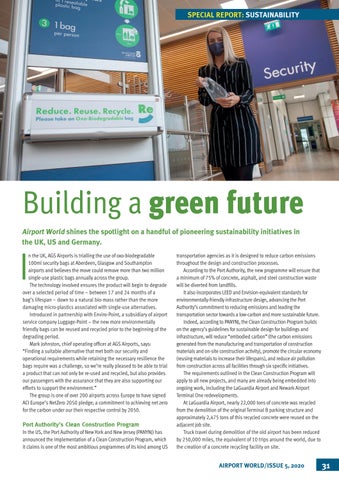SPECIAL REPORT: SUSTAINABILITY
Building a green future Airport World shines the spotlight on a handful of pioneering sustainability initiatives in the UK, US and Germany.
I
n the UK, AGS Airports is trialling the use of oxo-biodegradable 100ml security bags at Aberdeen, Glasgow and Southampton airports and believes the move could remove more than two million single-use plastic bags annually across the group. The technology involved ensures the product will begin to degrade over a selected period of time – between 17 and 24 months of a bag’s lifespan – down to a natural bio-mass rather than the more damaging micro-plastics associated with single-use alternatives. Introduced in partnership with Enviro-Point, a subsidiary of airport service company Luggage-Point – the new more environmentally friendly bags can be reused and recycled prior to the beginning of the degrading period. Mark Johnston, chief operating officer at AGS Airports, says: “Finding a suitable alternative that met both our security and operational requirements while retaining the necessary resilience the bags require was a challenge, so we’re really pleased to be able to trial a product that can not only be re-used and recycled, but also provides our passengers with the assurance that they are also supporting our efforts to support the environment.” The group is one of over 200 airports across Europe to have signed ACI Europe’s NetZero 2050 pledge; a commitment to achieving net zero for the carbon under our their respective control by 2050.
Port Authority’s Clean Construction Program In the US, the Port Authority of New York and New Jersey (PANYNJ) has announced the implementation of a Clean Construction Program, which it claims is one of the most ambitious programmes of its kind among US
transportation agencies as it is designed to reduce carbon emissions throughout the design and construction processes. According to the Port Authority, the new programme will ensure that a minimum of 75% of concrete, asphalt, and steel construction waste will be diverted from landfills. It also incorporates LEED and Envision-equivalent standards for environmentally-friendly infrastructure design, advancing the Port Authority’s commitment to reducing emissions and leading the transportation sector towards a low-carbon and more sustainable future. Indeed, according to PANYNJ, the Clean Construction Program builds on the agency’s guidelines for sustainable design for buildings and infrastructure, will reduce “embodied carbon” (the carbon emissions generated from the manufacturing and transportation of construction materials and on-site construction activity), promote the circular economy (reusing materials to increase their lifespans), and reduce air pollution from construction across all facilities through six specific initiatives. The requirements outlined in the Clean Construction Program will apply to all new projects, and many are already being embedded into ongoing work, including the LaGuardia Airport and Newark Airport Terminal One redevelopments. At LaGuardia Airport, nearly 22,000 tons of concrete was recycled from the demolition of the original Terminal B parking structure and approximately 2,475 tons of this recycled concrete were reused on the adjacent job site. Truck travel during demolition of the old airport has been reduced by 250,000 miles, the equivalent of 10 trips around the world, due to the creation of a concrete recycling facility on site.
AIRPORT WORLD/ISSUE 5, 2020
31
